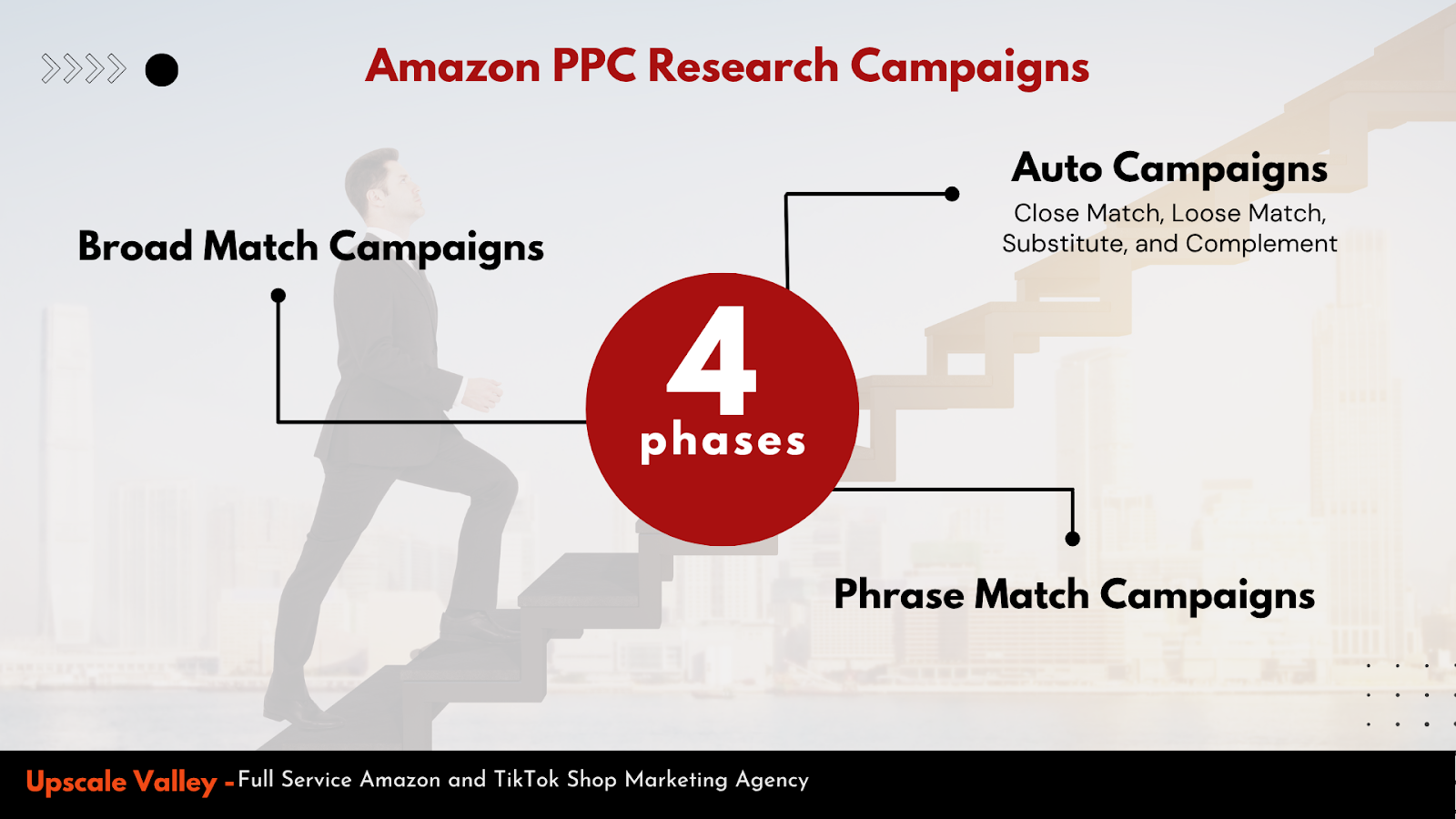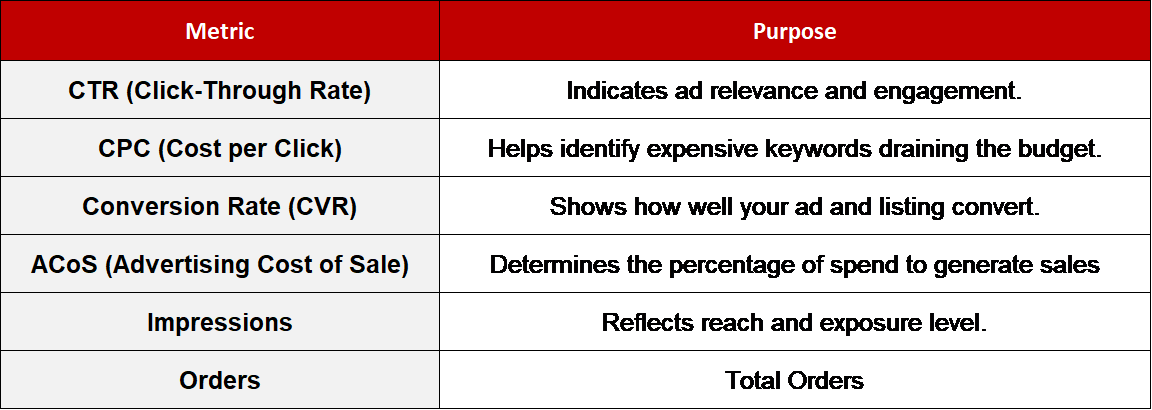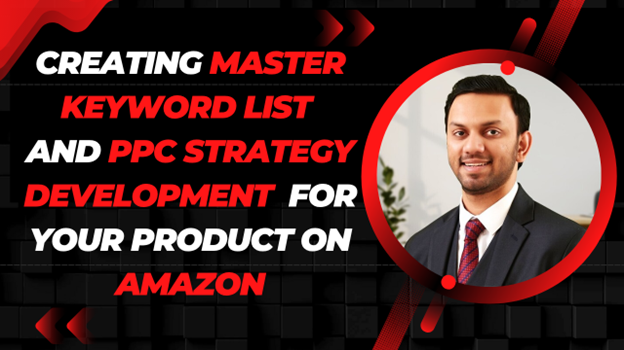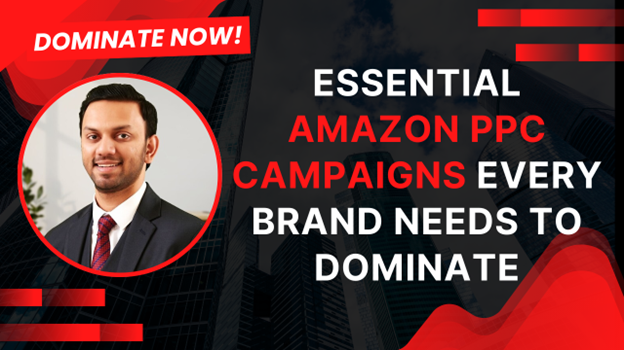Running profitable Amazon PPC campaigns is not just about spending money, it is about gathering the right data and using it to make informed decisions to maximize your campaigns performance. Every successful PPC strategy begins with a solid research phase, where you explore which search terms actually drive sales and which ones drain your budget, then you later need to target that good performing search term in a separate exact targeting campaign to dominate that particular search term.
Auto, Broad, and Phrase campaigns are one of the most useful methods to gather the potential search term for your products. These campaigns help you collect search term data, understand customer intent, and identify which keywords have the potential to be targeted more aggressively in Exact campaigns.
In this comprehensive guide, you will learn step by step how to properly structure, analyze, and optimize your Amazon PPC Research Campaigns.
1. Understanding Amazon PPC Research Campaigns
Before we jump into optimization, let’s clarify what research campaigns really are.
In the Amazon PPC world, research campaigns are designed to help you discover new, converting keywords and understand buyer intent. They are not primarily focused on securing ranks on potential keywords, but rather on data collection.
The Three Campaign Types Typically Used for Research Purposes in Amazon PPC

In the Amazon PPC world, the three campaign types primarily considered as research campaigns are Auto, Broad, and Phrase campaigns. Each of these campaign types plays a vital role in discovering new search terms and building a data foundation for your exact targeting campaigns.
1. Auto Campaigns
Auto campaigns allow Amazon’s algorithm to automatically match your ads with relevant search queries.
All types of auto campaigns — Close Match, Loose Match, Substitute, and Complement — are considered research campaigns.
These campaigns are one of the strongest sources for gathering potential search terms that you can later target through exact campaigns.
They usually have good profitability potential due to typically lower CPCs compared to keyword-targeting campaigns.
Want to learn how to master Amazon PPC from the ground up? Check out our complete Amazon PPC Guide for a step-by-step strategy from research to scaling.
2. Broad Match Campaigns
Broad match campaigns let your ads appear for search queries containing your keyword in any order, including synonyms and related terms.
For example, if the main keyword for your product is “diaper changing pad” and you are targeting it through an exact match campaign, you can also try running the same keyword in a broad match campaign.
However, it’s recommended to add the same keyword as a negative exact from the very start. This ensures your broad campaigns only show your ad for related terms — not the exact keyword — which helps prevent cannibalization between campaigns.
3. Phrase Match Campaigns
Phrase match campaigns display your ad when a customer’s search contains your keyword phrase in the same sequence, with additional words before or after it.
The strategy is similar to that of broad campaigns. You can target your main keywords through phrase campaigns, but if you are also targeting the same keywords in your exact campaigns, add those exact keywords as negative exacts in your phrase campaigns.
This ensures that your phrase campaigns target only the phrases that include your targeted keywords, but not the same exact terms, allowing you to gather broader data without overlapping traffic.
These campaigns are the backbone of your keyword harvesting strategy—the process of identifying high-performing search terms and moving them into more controlled exact campaigns.
2. Why Research Campaigns Matter
Research campaigns provide the data foundation of your Amazon PPC strategy. Without them, you're missing the ocean of potential high converting search terms of your product.
Here’s why they matter so much:
- Keyword Discovery: Identify which keywords actually convert best for your product.
- Data for Optimization: Learn what kind of phrases customers are using to engage with your product.
- Better Targeting: Move high-performing targets to exact campaigns for better control and higher ROI and improve your product ranks on that particular keyword.
- Budget Efficiency: Avoid wasting spend on irrelevant search terms by analyzing and negating poor performers.
- SEO Insights: Research campaign data can also help you refine your listing SEO and backend keywords.
If you skip this stage and go straight to Exact campaigns, you’ll miss the goldmine of high performing search terms and competitor ASINs for Product targeting campaigns and you will likely overspend and underperform.
Book a free Amazon PPC experts audit with Upscale Valley and let our experts help you build research campaigns that actually drive results.
3. How to Structure Your Research Campaigns Properly
The very first thing you need to do is to create your research campaigns in a proper structured and organized manner. A clear structure helps you in efficiently analyzing the overall campaign's performance and prevents data overlap.
A. Auto Campaign
- Create one Auto Campaign per ASIN or per product line.
- Create separate campaigns for each targeting type i.e Close, Loose, Substitute & complements.
- You can also use different ad groups if you want to test multiple variations (e.g., color or size).
- Set your default bid moderately (not too low, not too high) and give some placement percentages from the very start.
- Avoid adding negative keywords from the very start, let Amazon collect data freely for the first 7–14 days, then start doing necessary optimization.
B. Broad Match Campaign
- Target 2–3 main seed keywords per campaign.
- If you are running that particular keyword in the exact campaign also then do add that as negative exact in your broad campaign form the very start.
- Don’t overload your ad group; keep it clean for accurate data reading.
- Bids can be slightly higher than Auto campaigns to drive more traffic.
- Use exact negatives to block duplication from existing Exact campaigns.
- Do not run many ASINs per ad group otherwise you won’t be able to make wiser decision while optimizing your campaign
- In some product lines broad campaigns target to broader search terms and most of them are not as such relatable to our product, in such scenarios, It’s recommended to run a Broad Modifier Campaign instead of a simple Broad campaign, as the Broad campaign sometimes targets too broad keywords which seem to be kind of irrelevant for your product and your spend will be wasted. So when you use a Broad Modifier campaign, then it won’t target too broadly.
- Method of using Broad Modifier: For example, you have a keyword Diaper Changing Pad, then you need to add “+” sign after each word in the phrase like Diaper+ Changing+ Pad+.
C. Phrase Match Campaign
- Target mid-level intent keywords phrases that indicate buying behavior but still allow variations.
- Keep bids higher than Broad, as Phrase Match tends to be more relevant.
- Avoid combining too many keywords (limit to 5 keywords max per campaign).
- Phrase campaigns sometimes are the most powerful campaign type to provide a potential search term for your product.
For all these research campaigns, do optimize your campaigns once every week and add poorly performing search terms in negative once in every 2 weeks and also extract good performing target once in every 2 weeks or in a month
The idea is to build a testing environment where each campaign type plays a distinct role.
4. How to Optimize Amazon Auto Campaigns
Auto campaigns are your data goldmine, Amazon uses your listing information (title, bullets, description, backend keywords) to match your ad to customer searches.
A. Wait for Enough Data
Allow your Auto campaign to run for at least 10–14 days or until you collect enough clicks that can help you in making informed decisions. Optimization before sufficient data can mislead you.
B. Analyze the quickly through your Search Term Report
Go to your Search Term Report and apply a pivot table and find your desired campaign then identify:
- High-performing search terms → Low ACoS, multiple conversions.
- High-click, no-sale terms → Potentially irrelevant; consider adding as negatives.
- Irrelevant search terms → Add them as negative exact or negative phrases to cut wasted spend.
C. Create Segmentation Campaigns
Auto campaigns target four match types:
- Close Match
- Loose Match
- Substitutes
- Complements
You can split these into separate campaigns for better control.
Example:
- Auto Campaign 1 → Close Match
- Auto Campaign 2 → Loose Match
- Auto Campaign 3 → Substitutes
- Auto Campaign 4 → Complements
This lets you allocate budget more efficiently into all different higher-performing targeting types of auto campaigns (usually Close and Substitute).
D. Keyword Harvesting
Move top-performing search terms from Auto to Exact Match Campaigns for the precise control and to maintain strong ranks for your listing on those high performing search terms
Document everything in a keyword tracking sheet to avoid duplication and to keep the track of the overall performance of your product on the particular keyword.
Well If you want to learn in detail about how to do keyword research then check out our detailed blog on How to create your Master Keyword List and Strategy Development for Amazon PPC Campaigns
5. How to Optimize Broad Match Campaigns
Broad match campaigns help a lot in finding keyword variations, synonyms, and related terms customers use.
A. Start with target Seeds keywords through Broad Campaign
Pick 2–3 strong seed keywords from your niche and start targeting those through broad campaigns, but if these keywords are targeted through exact campaigns, then do add these as a negative exact from the very start so that it will target all the relatable terms, not the exact ones, and by doing this, you are preventing your portfolio from campaign overlapping.
B. Monitor Search Terms Closely
Since Broad allows wide matching, monitor your Search Term Report frequently.
- Add irrelevant or low-converting search terms as negative exact.
- Keep converting keywords aside for Exact targeting.
C. Adjust Bids Based on Intent
Broad matches often have mixed intent.
Use bid adjustments to prioritize profitable areas:
- High CTR + Conversions → Increase bid
- High Spend + No Sales → Reduce bid or negate keyword
D. Use Placement Reports
Check if your ads perform better at Top of Search or Product Pages.
Apply placement bid adjustments accordingly to maximize visibility on best-performing positions.
6. How to Optimize Phrase Match Campaigns
Phrase campaigns are a balance between control and exploration. They capture search terms that include your target phrase, allowing some variation while staying contextually relevant.
A. Start with targeting potential keywords through phrase Campaign to discover more relevant search terms
Pick some strong good performing keywords from your niche and start targeting those through broad campaigns, but if these keywords are targeted through exact campaigns, then do add these as a negative exact from the very start so that it will target all the relatable terms, not the exact ones, and by doing this, you are preventing your portfolio from campaign overlapping.
B. Set Bid Strategy Smartly
- Use slightly higher bids than Broad campaigns since Phrase traffic is more relevant.
- Monitor CPC trends and adjust based on conversion rate.
C. Regularly Mine Search Terms
Just like Broad, monitor your Search Term Report weekly:
- Move top converters to Exact Match.
- Negate poor performers.
D. Avoid Keyword Cannibalization
Ensure that a single search term isn’t appearing in multiple campaigns. Use negative exacts in your Phrase campaigns to block overlap with your Exact campaigns.
If you want to learn in detail about what are the essential PPC campaigns then check out our detailed guide on Essential Amazon PPC Campaigns Every Brand Needs to Dominate
Get in touch with Upscale Valley’s PPC team — we’ll audit your research campaigns and create a data-driven scaling plan tailored for your brand.
7. Keyword Harvesting Process
Keyword harvesting is the core of scaling your overall PPC Performance, turning data from research campaigns into profitable exact targeting.
Here’s how to do it effectively:
Step 1: Download the Search Term Report
Get data from all your research campaigns (Auto, Broad, and Phrase).
Step 2: Filter Based on Metrics
Look for:
- At least 2–3 conversions per term.
- ACoS below your target (e.g., < 35%).
- CTR above 0.5%.
Step 3: Identify 3 Categories of Keywords
- Keep / Expand – Strong performing terms to target more aggressively in Exact.
- Test / Optimize – Terms with potential but need further testing in Phrase or Broad.
- Negative / Exclude – Poor performers to add as negatives.
Step 4: Launch Exact Match Campaigns
Move top-performing search terms into new Exact campaigns with separate budgets.
This helps you scale profitable traffic while maintaining control.
If you want to learn in detail about Search Term Report Analysis then check out our latest blog on How to Extract Potential Search Terms and Analyze the performance using Amazon Search Term Report
8. Key Metrics to Track for Research Campaigns
To ensure your campaigns are moving in the right direction, monitor these core metrics regularly:

Always make data-driven decisions. Don’t rely on assumptions; every optimization should be backed by real numbers.
9. Common Mistakes Sellers Make with Research Campaigns
Avoid these common errors that can ruin your campaign performance:
- Pausing too early: You must wait to gather sufficient data before optimization.
- Combining too many keywords: Leads to poor data clarity and keyword cannibalization.
- Ignoring search term reports: You will never know what’s actually converting.
- No negative targeting: Wastes money on irrelevant searches.
- Not moving keywords to exact campaigns: Limits scaling potential of your PPC Campaigns.
- Overlapping targeting: Causes internal competition among your own ads.
Fixing these mistakes will instantly make your campaigns cleaner and more cost-efficient.
12. Final Thoughts
Optimizing your Amazon PPC research campaigns isn’t just about cutting costs—it’s about building a data-driven foundation for long-term growth.
Auto, Broad, and Phrase campaigns are not designed to be profit engines on day one—they’re built to discover what works. Once you understand which search terms are converting, you can shift them to Exact campaigns and scale your brand profitably.
Every click, impression, and keyword gives you a piece of the bigger picture. The more organized and consistent you are with analyzing this data, the faster you’ll achieve PPC success on Amazon.
So, don’t underestimate your research campaigns—they’re your training ground for every profitable PPC decision that comes next.
Run them for at least 10–14 days or until each campaign collects enough data before making major changes.
When any particular search term is performing very well in your research campaigns for the past few weeks and you are not targeting that keyword through an exact campaign, then you can consider moving this keyword to an exact targeting campaign.
Yes, especially after you identify which placement (Top of Search or Product Pages) delivers higher conversions.
Yes, Auto Campaigns discover new search terms for your product, while Broad explores more related search term variations of those you are targeting through broad campaigns.
Research campaigns generally have a good ACoS as compared to your exact targeting campaigns, as the CPCs in auto campaigns are lower than keyword targeting campaigns.




.avif)
.svg)


.png)
.jpg)
.svg)







